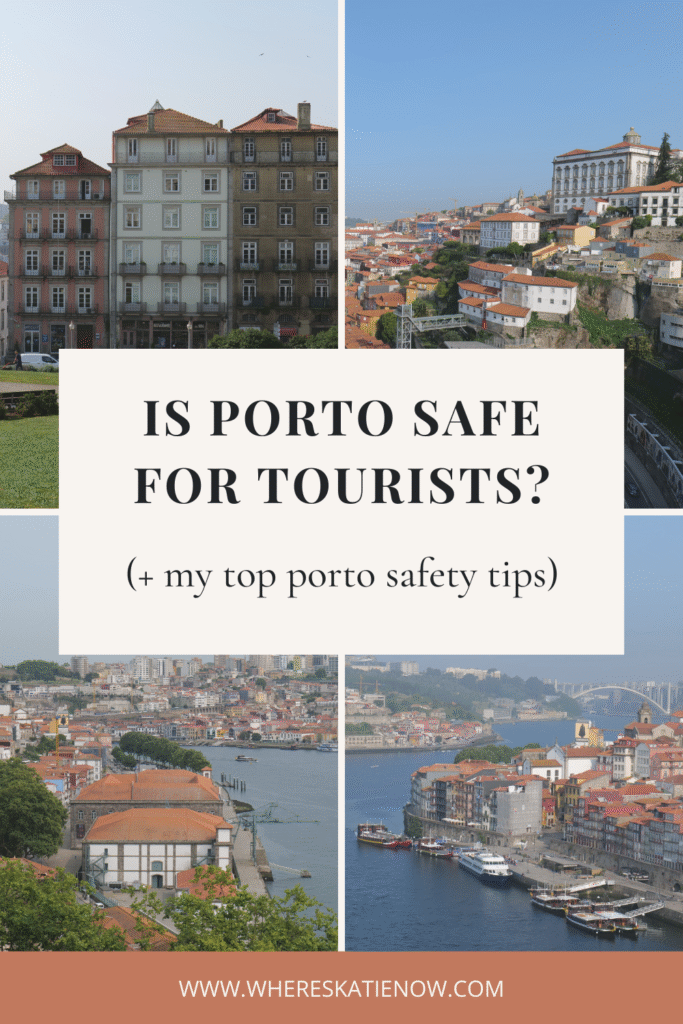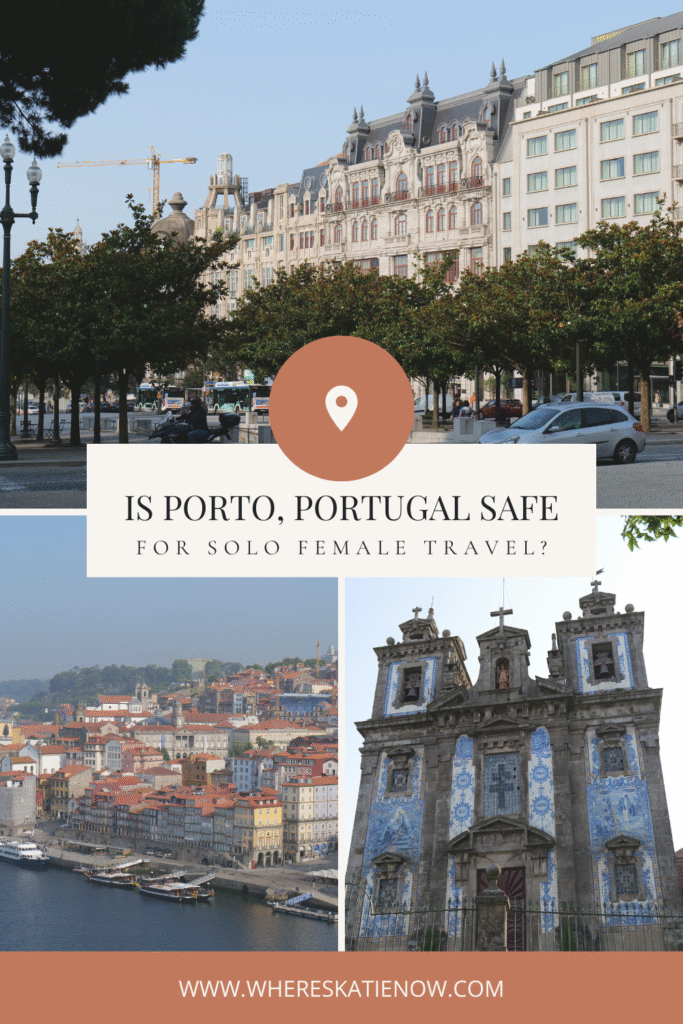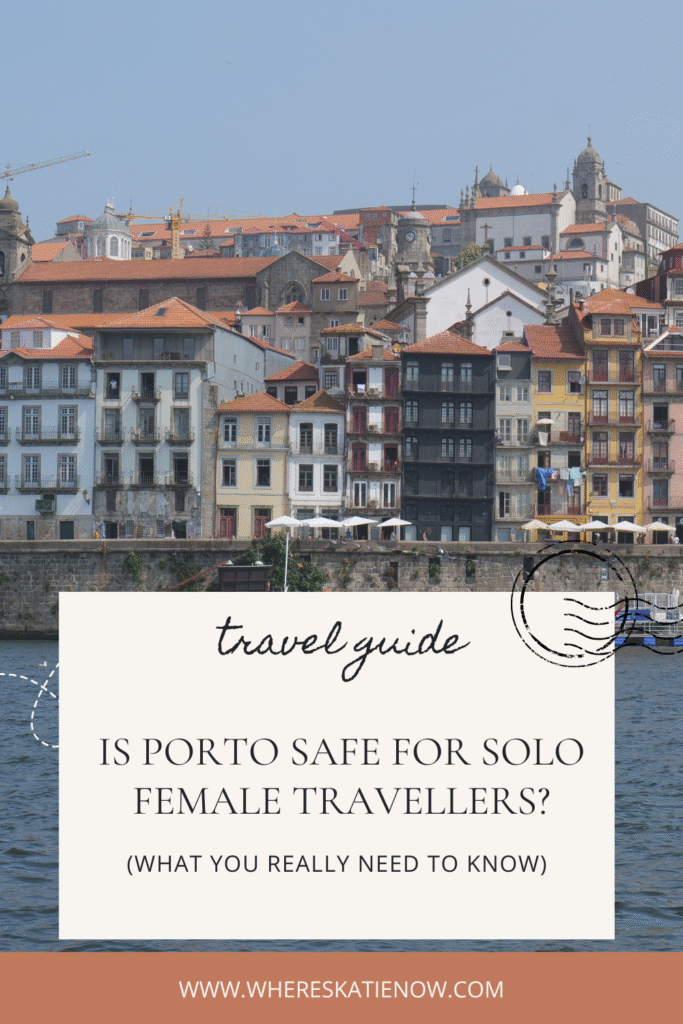Is Porto Safe For Solo Female Travellers? Porto Safety Tips
So, is Porto safe for solo female travellers? Let’s be real – that’s almost always the first thing that pops into your head when you picture yourself exploring those steep cobbled streets or sipping Port wine in the sunshine alone.
It’s exciting and more than a little nerve-wracking at the same time. I get it.
Well, I’ve travelled in Porto as a solo female traveller, from evening city strolls to squeezing onto the busy public transport, so I absolutely know the little questions that run through your mind…
- Will I stand out as a solo traveller?
- Is it safe to walk back to my hotel after dinner?
- What’s the vibe with locals?
And those questions are exactly why I created this guide. I want to give you the honest answers I wish I’d had before my first trip to Porto.
We’re going to cover everything that actually matters when you’re travelling here alone. Things like how safe Porto feels day and night, what the crime rates really look like, the areas you’ll love (and the ones worth skipping), plus my tried-and-tested safety tips!
By the end, you’ll know exactly what to expect and (hopefully!) feel a whole lot more confident about making this trip happen. Let’s get to it!
Disclaimer: Some of the links on this blog are affiliate links. That means if you click on one and make a purchase, I may earn a small commission – at no extra cost to you. I only recommend products, places and services I genuinely love and use on my own solo travels. Thank you for supporting my adventures so I can continue to provide free content on this blog! 💛
Is Porto Safe for Solo Female Travellers?
The short answer? Yes, Porto is generally a very safe city for solo female travellers.
In fact, Portugal is considered to be one of the safest countries in the world, ranking 7th on the Global Peace Index, far ahead of other popular European destinations like Italy (33rd) or even Norway (28th).
The U.S. government also ranks Portugal at Level 1: exercise normal precautions, which is the safest possible travel advisory it can give.
But don’t get me wrong – those encouraging stats definitely don’t mean that Porto is risk-free.
Like any major city, Porto has challenges when it comes to crime.
Petty crime (like pickpocketing), or the occasional tourist scam are the most common crimes against tourists in Porto.
But during my own solo trip to Porto (including walking back from dinner after dark, hitting up all of the key attractions, and taking busy public transport), I never once felt really uneasy.
Katie’s Top Tip: If you take only one thing away from this guide, please let it be this: awareness goes such a long way to keeping you safe while travelling. Keep your bag zipped, know your route home at night and stay alert in busy public spaces, and you’ll most likely be just fine.

Understanding Porto’s Culture
Porto, like most of Portugal, feels very safe. And I would definitely say that a big part of the reason why is because of its relaxed culture.
At its heart, Porto is still very much a local, working city with a slower, more traditional pace than Lisbon.
In my experience, locals in Porto are very warm, polite and respectful of your space, but are also more than happy to help if you need them to.
But that working, lived-in feel also has a flipside – the further you explore away from the Ribeira riverside or Baixa (typically touristy neighbourhoods), the more you’ll see the grit that sets Porto apart from Lisbon.
In certain neighbourhoods, graffiti, run-down buildings, and the odd group hanging around are common sights. (We’ll get to this in the “Places to avoid in Porto” section!)
But I found that even though walking through these areas felt a little more uncomfortable (and I wouldn’t visit alone at night), I was still totally safe.
2025 Update: Porto, like a lot of European cities, has seen small but growing protests against mass tourism.
Locals are worried about rising rents and overcrowding, which makes it more important than ever to be mindful and respectful of how you are travelling.
But don’t let this put you off. Porto is still a warm, welcoming and friendly city. And it definitely isn’t experiencing the tourism pressures and mass demonstrations of other cities, like Barcelona.
Katie’s Top Tip: Be respectful when visiting Porto. Things like keeping noise to a minimum (especially at night), supporting local businesses, and treating the city like someone’s home (because it is!)
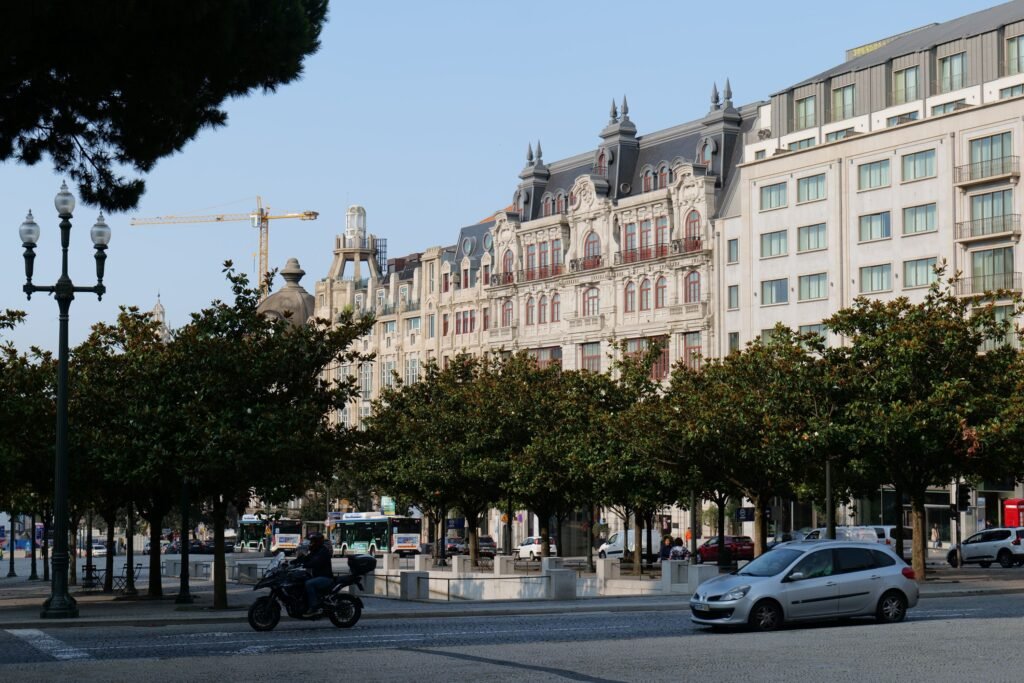
Attitudes Towards Women in Porto
I don’t know about you, but one of the biggest fears about travelling solo as a woman is: will I be treated differently as a woman on my own?
In Porto, I found I definitely wasn’t, largely thanks to how popular solo travel (and solo female travel) is in Portugal.
Portuguese culture is generally very respectful of women, and catcalling is far less aggressive or common than in many other southern European countries.
And personally, I had no uncomfortable moments during my solo trip to Porto, unlike in cities like Zadar or Rome.
But, unfortunately, as a woman out anywhere (at home or abroad), no place is perfect, so you might still encounter mild street harassment.
The most common reports are around nightlife areas, like Galerias de Paris, and usually involve catcalling or an inappropriate comment.
It’s rarely threatening, but it is never, ever okay. You are valid in whatever it makes you feel.
Katie’s Top Tip: If you experience street harassment in Porto, don’t engage. My personal advice is to try to ignore it and walk past with confident body language (even if you’re not feeling it). But if it continues or you feel unsafe to continue walking alone, head inside the nearest café, restaurant or shop to get help.
How to Dress in Porto
You don’t need to overthink what to wear in Porto. Unlike other countries, Portugal doesn’t have strict dress codes or modesty rules due to its culture.
In my experience, locals dress casually but in a way that is put-together. Think things like jeans, trainers, light jackets, and minimal accessories.
As a touristy city, you’ll of course see a whole range of styles, and in summer, you’ll also see plenty of people wearing sundresses and shorts, so you more than likely don’t have to change up your style at all to fit in here.
When I visited in summer, I packed a collection of midi dresses, wide-leg trousers and neutral tops, and felt like I blended in just fine.
But one piece of advice: leave those high heels at home! (Lisbon may be famous for the hills, but Porto is steep too, so comfort is key!)
I also leave any revealing outfits at home. I don’t like attracting attention when I’m solo travelling and prefer to blend in with locals. But that’s of course just my personal preference – you do you!
Katie’s Top Tip: Pack one nicer outfit if you want to enjoy Porto’s nightlife. But otherwise stick to practical layers and comfy shoes. (You can thank me when you’re walking up those hills!)
Porto Crime Rates
Numbers always help put safety into perspective, right? So let’s break it down!
According to Numbeo, Porto’s level of crime is considered low, with safety walking alone during the day scoring very high and walking alone at night scoring moderate.
The most common crimes reported are property-related (like theft from cars, for example), rather than violent crime (rated low).
As a solo female traveller, one stat I pay close attention to is concerns about attacks based on gender or ethnicity – and in Porto this is ranked as very low.
To give you context, this makes Porto safer than many popular European cities, including Rome, Paris and Barcelona.
Katie’s Top Tip: Always keep perspective. The crime rate in Porto, Portugal, might sound scary when you see numbers out of context or read clickbait headlines about crime increases. But the reality on the ground is that Porto feels very safe.
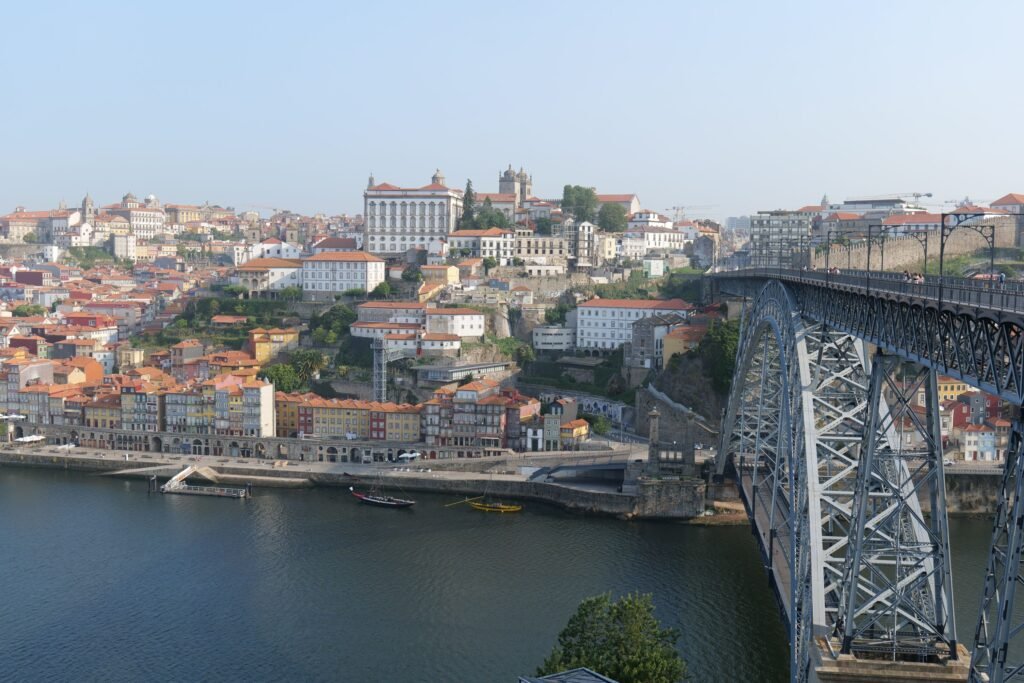
Risk of Theft in Porto
While the overall Porto crime rates are low, petty theft does happen (usually in busy, touristy areas like Ribeira, São Bento Station and on public transport).
Theft in Porto is also usually opportunistic rather than aggressive.
Things like snatching unattended bags or valuables poking out of pockets being pickpocketed, rather than violent theft.
Prime spots for pickpocketing in Porto (where you should be extra careful of your belongings) are:
- Ribeira waterfront
- São Bento Station (and the surrounding streets)
- Trams and public transport
- Dom Luís I Bridge
- Mercado do Bolhão
- The main shopping streets of Avenida dos Aliados, Baixa and Santa Catarina
- Campanhã Station
I’m not giving you this list to scare you or make you paranoid, but so you can stay aware and ensure you are mindful of your belongings in these areas.
But you are not more or less likely to be targeted because you’re a solo traveller, as opportunistic thieves look at how distracted you are over anything else.
Luckily, small solo travel safety habits – like using a zipped crossbody bag for valuables, not leaving your phone on a café table and keeping a hand on your bag in crowds – will go a long way to making you look less like a target.
And those all-important stats back this up too.
Numbeo lists worries about being mugged or robbed as low, while theft from cars is a bigger issue, ranking moderate.
Katie’s Top Tip: Keep your bag zipped and in front of you in busy spaces. I always use a slim crossbody bag with a hidden pocket for my phone and valuables. That way, you can relax and enjoy your trip without constantly feeling paranoid about your bag!

Risk of Terrorism in Porto
The risk of terrorism in Porto is incredibly low.
Statista confirms there hasn’t been a recorded terrorist attack in Portugal since 2011, and Porto itself hasn’t experienced anything for decades either.
To put it in perspective, Portugal ranks 7th on the Global Peace Index, far ahead of countries like Italy (33) or Croatia (15). The U.S. Department of State also lists Portugal at Level 1, which is their lowest and safest ranking.
Don’t get me wrong, the risk here definitely isn’t zero (it never is anywhere in the world, especially in these increasingly unstable times), but compared to other European destinations, Porto feels a lot safer.
Katie’s Top Tip: If scary news headlines are making you nervous to travel, download your local government’s app instead or sign up for alerts about Portugal. That way, you’ll stay informed with accurate knowledge, rather than relying on (often clickbait) headlines.
Risk of Violent Crime in Porto
The fear of violent crime is one of those fears that can really hold you back from wanting to solo travel as a woman, right?
Well, violent crime in Porto is rare. Numbeo scores the risk of assault or armed robbery and worries about being attacked as low.
Personally, I’ve walked home at night in Porto many times, after dinner, and never once felt physically unsafe during my trip.
But, like any city, things can happen, so being aware of your surroundings (always, but especially at night) is just a smart solo travel safety tip to follow.
If violence does occur in Porto, it’s less likely to be targeted at tourists and more likely a spur-of-the-moment altercation after alcohol has been involved.
Porto’s nightlife scene is growing in popularity, so avoid areas around Galerias de Paris if nightlife or rowdy drunken behaviour makes you feel uncomfortable.
This is especially true around the time the bars close.
Katie’s Top Tip: Stick to well-lit streets and main routes at night, and if you’re ever unsure, taxis in Porto are safe and affordable. If you’re out and about after midnight, I would always call for one rather than walking, just for your peace of mind.
Risk of Harassment in Porto
This is a tough one. Because harassment is unfortunately so common against women everywhere, whether travelling or not.
And even if it’s not “dangerous”, it still for sure impacts how safe you feel.
During my solo trip to Porto, I personally never experienced or witnessed any street harassment.
But from what I’ve heard from others and read in the stats, catcalling and unwanted attention do still affect women (both tourists and locals), in Porto – especially in nightlife settings.
According to Numbeo, worries about being insulted score low, and gender-based harassment is rated very low.
One thing I will say though, is that on Friday/Saturday nights, I definitely noticed more male groups around and some street drinking in the city centre.
And while I was never harassed or witnessed anything of that sort, the atmosphere felt rowdier and less comfortable compared to the daytime or even weeknights.
Katie’s Top Tip: If you ever feel uncomfortable, don’t hesitate to cross the street or head into the nearest shop, café or restaurant until you feel safe to continue walking. I don’t know who needs to hear this, but trusting your gut is not overreacting; it’s what keeps you safe.
Risk of Pickpocketing in Porto
Pickpocketing is the most common safety issue tourists experience in Porto.
And the hotspots are predictable: São Bento station, busy public transport, tourist trams and the Ribeira waterfront.
These are areas where wannabe thieves know travellers are distracted by taking photos or navigating.
It’s not something that should scare you off visiting Porto, but it is something to actively protect yourself against with a zipped bag for valuables and general awareness of surroundings.
Katie’s Top Tip: From experience, the tactics are the same as in most European cities: someone bumping you on a tram, a distraction scam, or an overly friendly stranger in a crowded spot… So remember to stay aware.
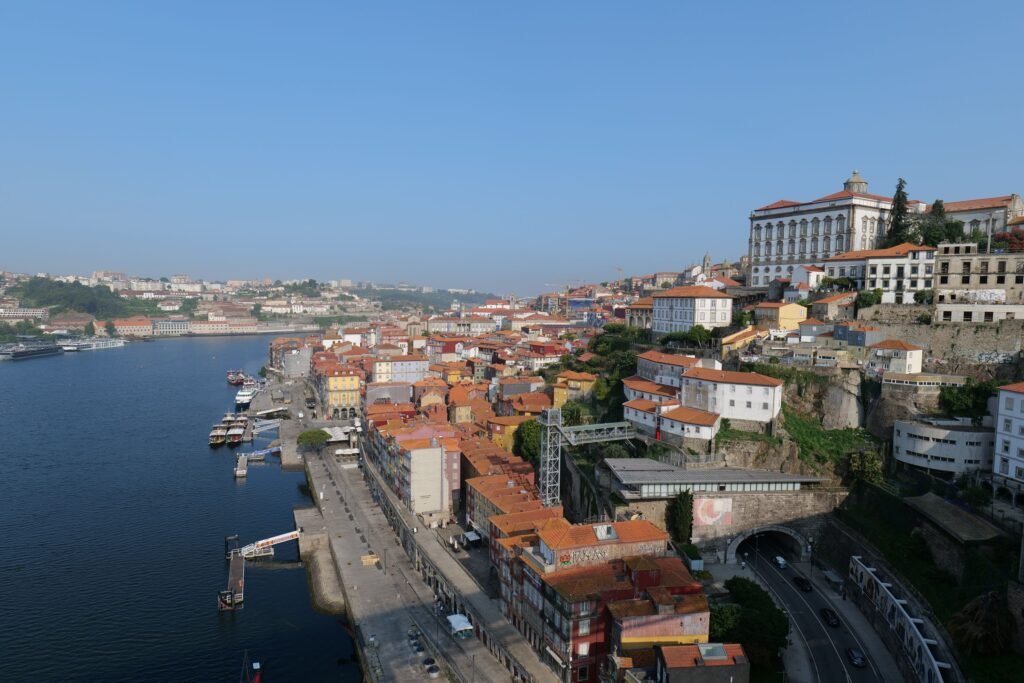
Risk of Scams in Porto + Common Scams to Watch Out For
Compared to bigger tourist cities like Barcelona or Rome, scams in Porto are way less common, but they do exist, so it’s always better to know about them before you travel.
The most typical scams in Porto I’ve heard about are distraction-based.
Here are the most common tourist scams in Porto:
- Fake Rentals – Apartments that don’t exist (or have no right to be rented out) are listed online to steal deposits. Always book through reputable booking platforms.
- Unlicensed Taxis – Drivers overcharging or using fake meters, especially at the airport. Stick to official taxis or Uber to avoid this.
- Pickpockets on the Dom Luís I Bridge – Porto’s most famous bridge is a prime location for wannabe thieves, so keep your belongings close.
- Fake Parking Attendants – People claiming you need to pay them instead of the machine. Only pay official meters.
- Charity/Petition Collectors – Clipboards and fake causes designed to guilt you into a cash donation. Alternatively, they use this to get your attention while someone else pickpockets you. Just walk away.
- Restaurant Overcharging – Extra charges for bread/olives you didn’t order. Always check menus and reviews before sitting down.
- Fake Tours & Tickets – Bargain boat trips or wine tours that don’t exist. Only book through licensed operators.
Personally, I’ve always found Porto’s locals to be super respectful, friendly and welcoming, but awareness of these common scams is still key so you know what to watch out for.
Katie’s Top Tip: If anyone approaches you with a deal that feels too good to be true, it probably is. Book tours directly with reputable companies online, and always trust your gut. If you’re uncomfortable, a firm no and walking away is more than enough – no explanation needed.
Porto Emergency Number
The emergency number in Porto is 112, and it works for police, ambulance and fire, just like 999 in the UK or 911 in the US.
This is also the same number for the whole of Portugal and Europe.
You’ll also see the PSP (Polícia de Segurança Pública) around central Porto. They’re approachable and used to helping tourists, so don’t hesitate to speak up if you feel unsafe or need help.
Katie’s Top Tip: Save 112 in your phone before your trip, with the name of your accommodation, so you can quickly give it to emergency services if needed.
The Safest Places to Visit in Porto
When it comes to safe neighbourhoods in Porto, the main tourist areas are generally very safe for solo female travellers, especially during the day.
- Ribeira (even though it’s crowded!) is very safe to walk through – just watch out for pickpockets.
- Gaia (opposite Ribeira) is grittier than Porto but still popular thanks to its wine cellars and spectacular viewpoints. I felt very safe here.
- The historic centre around São Bento Station and Avenida dos Aliados (Porto’s central boulevard) is also lively and well-patrolled by police.
- Foz do Douro is a seaside area that feels very relaxed and safe, with long promenades, beach cafés and families out walking.
- The Crystal Palace Gardens is my favourite spot in Porto and feels very calm and safe! This public park is peaceful and has incredible Douro River views. It’s also very popular with locals, so you never feel isolated.
Statistically, Porto’s crime rates are low overall, but sticking to these popular neighbourhoods will definitely add an extra layer of comfort to your trip.
Katie’s Top Tip: If you’re staying in Porto during your trip, choose accommodation in central or riverside areas. They are convenient places to stay, but also safer than staying out in the suburbs, with streets that are rarely quiet, plenty of people around and good public transport.
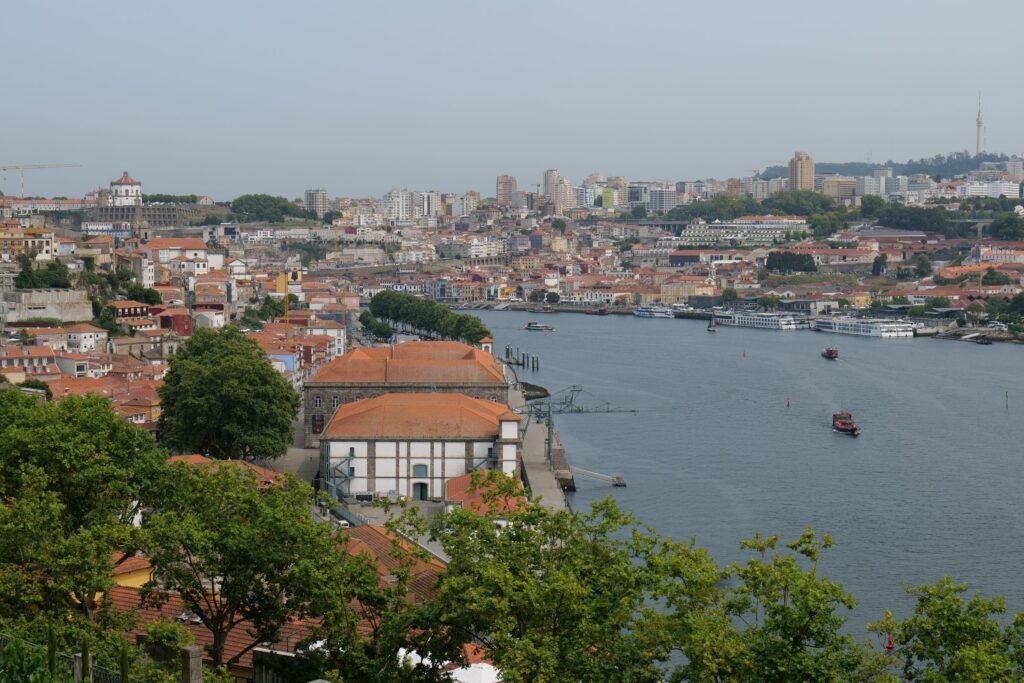
Places to Avoid in Porto
Yes, Porto is generally a very safe city, but there are still a few neighbourhoods where tourists shouldn’t venture (and, to be honest, you wouldn’t have much of a reason to visit anyway).
Neighbourhoods including Aleixo, Pinheiro Torres, and Cerco do Porto (all on the outskirts of Porto) have higher levels of crime, drug activity and poverty. Definitely avoid walking here at night, but really, they are out of the city centre, and you would have little reason to pass through at any time.
Ermesinde and Campanhã, can also feel a bit grittier and less comfortable. Campanhã in particular is Porto’s major transport hub, so you will likely visit here, but I would advise you walk with purpose in the surrounding streets and try to avoid the area after dark if possible.
Pasteleira do Meio and parts of Bonfim have also seen issues with drugs and vandalism.
Porto also has red-light districts, and Cerco do Porto is the most well-known. Like in any big city, these areas attract illegal activity. So as a solo female traveller, I would recommend avoiding Cerco at all times of day.
Another place I’d visit with caution is the quiet backstreets around Bolhão and Trindade station at night. During the day, they’re totally fine, but after dark, there is less lighting and fewer people around.
Katie’s Top Tip: If you stick to Porto’s central neighbourhoods (Ribeira, Aliados, Clérigos, Boavista), you’ll definitely feel more comfortable, especially at night. And when in doubt, ask a member of staff at your accommodation for advice.
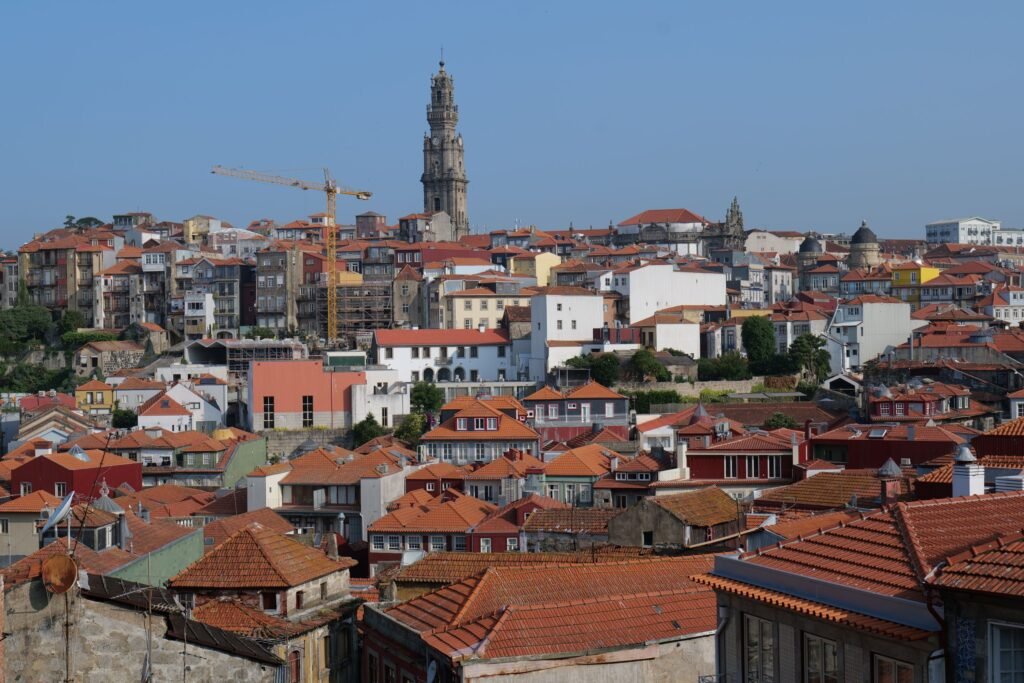
Is Porto Safe at Night?
This is by far the biggest question I get about solo travel safety, and in Porto, the answer is yes, but with just a few cautions.
Numbeo ranks safety walking alone in Porto at night at moderate, compared to very high during the day.
That doesn’t mean you should be paranoid, but you should stay more alert and aware when out and about after dark, using common sense like sticking to main streets, watching your alcohol and booking a taxi home if you’re unsure.
The nightlife areas in particular, like Galerias de Paris and Rua Cândido dos Reis, are lively until the early hours (especially in summer).
But while that means you won’t be isolated, crowds and alcohol can still raise the risk of petty theft or harassment.
However, Porto’s atmosphere at night is definitely much calmer than Barcelona’s or Rome’s or even nearby Lisbon’s.
The usual night-time safety rules still apply though:
- Stay alert
- Don’t overdrink
- Always know how you’re getting home
- Trust your instincts if something or someone feels off
Katie’s Top Tip: If you want to enjoy Porto after dark but feel nervous about going out alone, book evening tours. In Porto, you could go to a live fado show with dinner and wine, book a sunset cruise along the Douro River or even join an organised bar crawl.
Nightlife in Porto
As I said in the last section, Porto’s nightlife is definitely not as popular or chaotic as Lisbon’s, but it’s still vibrant.
On the ground, the main nightlife areas like Ribeira, Galerias de Paris and Rua Cândido dos Reis are lively, well-lit and busy with both locals and tourists well into the early hours.
But I’m not gonna sugarcoat it: nightlife anywhere (not just in Porto) can definitely be a little more complicated when you’re a woman travelling alone.
Petty theft is the biggest issue, with spikes in pickpocketing reports in crowded bars.
And, like everywhere, there is a potential for harassment or catcalling in these types of settings, too.
My advice? I keep evenings fairly low-key, choosing a sit-down restaurant, a sunset boat tour with drinks included or dinner and a Fado show.
Katie’s Top Tip: Always know your way home before going out so you’re not fumbling with your phone on a dark street, possibly after having a drink. Porto’s centre is compact, so you’re usually never more than a 15-minute walk from your accommodation, but only walk back if the route is well-lit and there are still people around. If in doubt, a taxi or Uber is always your best bet.
Safest Time of Year to Visit Porto
One of the best things about Porto is that it genuinely feels safe all year round!
Unlike some destinations where tourist seasons affect safety or, at the very least, vibe, Porto’s low crime rate means you won’t feel uncomfortable, even in the off-season with fewer tourists around.
But, as with anywhere, there are still things to consider before choosing your perfect time to visit Porto:
Summer (June–August) brings hot weather and big crowds too, especially in Ribeira and at major festivals like São João in June. More people also means more pickpockets, so while it’s a fun and vibrant time to visit, you’ll need to stay alert.
Winter (December–February) is quieter and cheaper, but it gets dark earlier, and Northern Portugal can be rainy, which can make going out (especially in the evening) less comfortable with fewer locals and tourists about.
Personally, I love spring (April–May) and early autumn (September–October) in Porto. The weather is warm (but temperatures aren’t too hot), the streets are lively but not overcrowded, and the prices aren’t at their peak, so you can enjoy Porto’s best spots without feeling overwhelmed.
Katie’s Top Tip: If you want the safest-feeling experience with good daylight hours, aim to visit Porto during shoulder season (spring or early autumn).
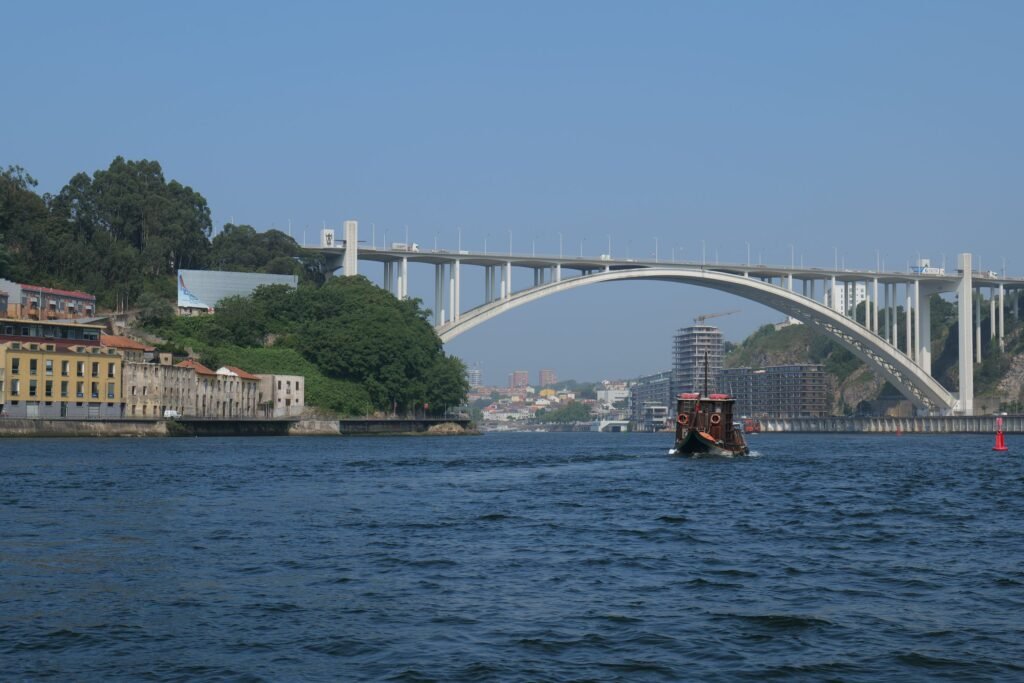
Is English Spoken in Porto?
A language barrier is always anxiety-inducing, especially when it comes to solo female travel safety.
But the good news is that in Porto, English is widely spoken.
In particular, younger locals, people working in hospitality, restaurants, and transport staff, nearly always speak good enough English to help you out if needed.
At tourist hotspots and in the city centre, I was fine communicating in English 99% of the time.
However, locals, of course, speak Portuguese natively, so you may have challenges in smaller restaurants, bakeries or cafes – especially further from the city centre.
Katie’s Top Tip: Download Portuguese on Google Translate offline before your trip. Even if you never need it, it’s so helpful to have on hand just in case you need to translate a menu, sign or communicate with a local who doesn’t speak English.
Is Public Transport Safe and Reliable in Porto?
Yes! Porto’s public transport is safe and reliable, and a very easy way to get around the city (although Porto is also incredibly walkable, and I recommend that for most sightseeing).
The metro that connects the airport to the city centre takes about 30 minutes and is one of the easiest airport connections I’ve used anywhere.
Local buses also run to most neighbourhoods, and trams or funiculars can get you up and down those steep hills without breaking a sweat!
The Funicular dos Guindais between Ribeira and the city centre is particularly useful.
And I’ve never had any issues with public transport in Porto.
In terms of safety, public transport in Porto is generally safe but like anywhere, petty theft does happen. So keep your bag zipped and in front of you and stay alert, especially during rush hour.
And if you’re wondering, are taxis safe in Porto? My answer is yes!
Taxis in Porto are regulated and metered, so as long as you use a reputable company, like Porto Taxis, Invicta Taxis or Raditaxis, you’ll be fine.
Ride-hailing apps like Uber, Bolt or FreeNow are also common in the city. Plus, they also give you that added reassurance of driver details and GPS tracking that you can share with loved ones back home, too, if you wish.
Katie’s Top Tip: If you’re arriving late at night at the airport, skip the metro and book a taxi straight to your accommodation. It’s inexpensive (usually €20–25 to the centre), avoids waiting around with luggage and is absolutely worth it for peace of mind.
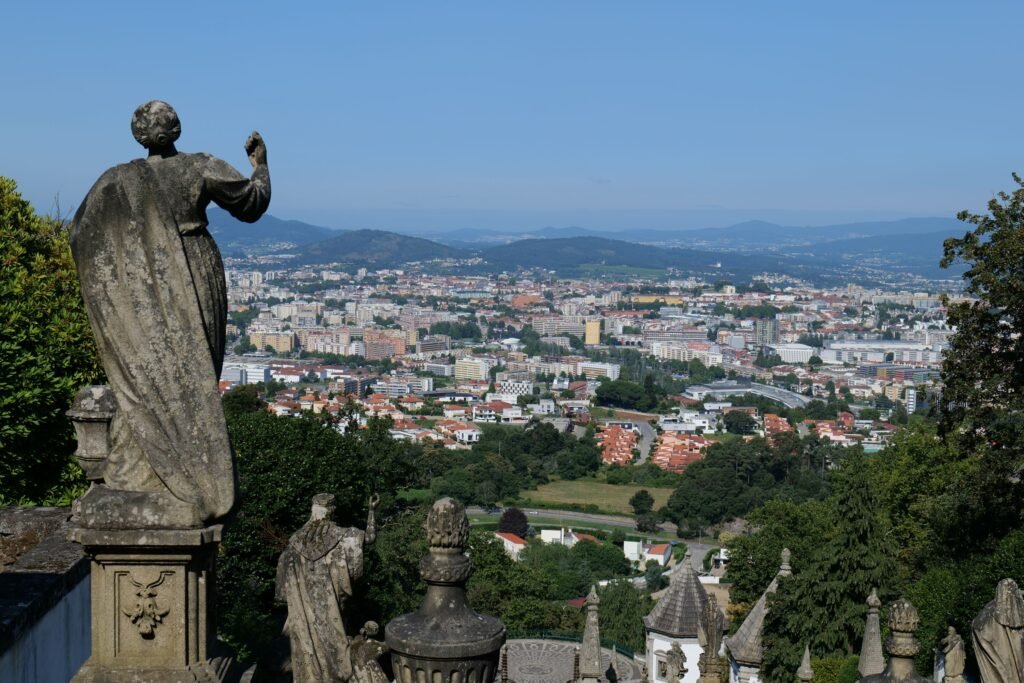
Top Solo Female Travel Safety Tips for Porto
So, even though I hope I’ve shown you in this article that Porto is safe for solo female travellers overall, it still helps to travel with a few smart safety habits in mind!
Based on my time travelling in Porto solo, and on my wider experience as a solo female traveller who has now visited 24+ countries alone, these are the ones that really make a difference:
- Stick to well-lit, central areas at night. Ribeira and Baixa are safe neighbourhoods in Porto for solo travellers, but avoid wandering alone through empty backstreets after dark.
- Keep your bag zipped and in front of you in busy areas like São Bento station, Mercado do Bolhão, or on public transport. Pickpocketing is the most common issue affecting tourists in Porto.
- Learn how to spot common scams: fake petitions, over-friendly “helpful” strangers, taxis without meters running or booking tours or accommodation from unregulated providers.
- Trust your gut instincts, always. Porto’s locals are friendly, but if something or someone’s behaviour feels off, it’s okay to walk away. You don’t owe anyone an explanation or politeness at the expense of your safety or comfort.
- Save the emergency number (112) in your phone. It works across all of Portugal and Europe, and connects you to police, ambulance and fire services.
Katie’s Top Tip: Where you book your accommodation is key, so make sure you choose somewhere central. My favourite hack for this is to go on Google Street View and “walk” the neighbourhood. Look for evidence of shops, restaurants, street lighting and public transport connections in the surrounding area. If a street doesn’t have that, it’s likely going to be too isolated for you to feel comfortable on the ground.
Conclusion: So, Is Porto Safe for Solo Female Travellers?
So, after breaking it all down, is Porto safe for solo female travellers?
Well, my short answer (as you might have guessed!) is yes.
Porto consistently ranks as one of the safest cities in Europe, with low crime rates and friendly and welcoming locals.
Portugal is also classed as a Level 1 country by the US State Department (the lowest travel advisory), and it also sits at number 7 on the Global Peace Index, which is far ahead of many other popular European destinations.
Violent crime is also low in Porto, and the biggest risk to visitors is pickpocketing in busy tourist hotspots or the odd common tourist scam. But both of these can be avoided with some smart precautions and a bit of knowledge (which you now have!)
Plus, going beyond the numbers for a second, Porto simply feels safe as a woman alone.
Its compact size, walkable centre, reliable public transport and welcoming, largely English-speaking locals make it super easy to explore alone.
Of course, like in any city, you should use common sense: keep an eye on your belongings, avoid empty streets late at night, know your way home before heading out, book central accommodation…
But you definitely don’t need to feel constantly worried or paranoid about safety as you explore.
Happy travels!
Read More About Travel to Portugal:
- Is Porto Safe For Solo Female Travellers? Porto Safety Tips
- How to Spend 3 Days in Porto: Your Perfect Porto Itinerary
- The 7 Best Day Trips From Porto (No Car Needed!)
- 17 Best Things To Do Alone in Lisbon For Solo Travellers
- 11 Best Day Trips from Lisbon You’ll Wish You Knew Sooner
Grab Your Solo Female Travel in Europe Starter Kit:
Pin Me For Later!
